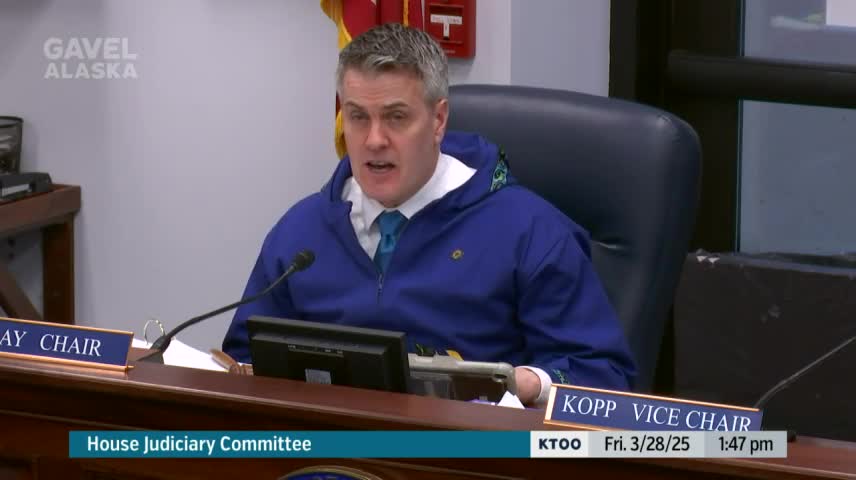Representative Gray proposes amendment to Council on Human Trafficking bill
March 28, 2025 | 2025 Legislature Alaska, Alaska
This article was created by AI summarizing key points discussed. AI makes mistakes, so for full details and context, please refer to the video of the full meeting. Please report any errors so we can fix them. Report an error »

In a pivotal meeting of the Alaska State Legislature's House Judiciary Committee, lawmakers gathered to discuss House Bill 118, aimed at addressing human trafficking. The atmosphere was charged with urgency as representatives debated the nuances of the proposed amendments, particularly one that sought to include a labor or trade organization leader on the council dedicated to tackling this pressing issue.
Representative Gray, the bill's sponsor, introduced Amendment 1, which sparked a lively discussion. The amendment aimed to enhance the council's representation by adding a member from a labor or trade organization, a move that emerged from public testimony highlighting the need for broader insights into labor trafficking. Gray emphasized the importance of this addition, noting that union leaders possess firsthand knowledge of the conditions faced by workers in industries vulnerable to exploitation.
However, the proposal faced objections. One representative raised concerns about the appropriateness of union representation, questioning whether union members could adequately represent the interests of trafficking victims, particularly in labor contexts where exploitation often occurs. This concern underscored the complexity of the issue, as the representative pointed out that those involved in trafficking often have ties to the very industries that employ vulnerable workers.
Despite the objections, Gray defended the amendment, arguing that labor leaders are crucial allies in the fight against trafficking. They are on the ground, aware of the realities faced by workers, and can advocate for fair treatment and protection against exploitation. The discussion highlighted the delicate balance between ensuring adequate representation for victims and addressing the potential conflicts of interest that may arise from union involvement.
As the meeting progressed, other representatives joined the conversation, seeking clarity on the definition of trade organizations and their relationship to unions. Vice Chair Cough noted that Alaska is home to numerous strong trade organizations that operate independently of unions, further complicating the landscape of representation on the council.
The meeting concluded with a sense of urgency surrounding the need for effective measures to combat human trafficking in Alaska. The discussions reflected a commitment to ensuring that all voices, especially those of vulnerable workers, are heard in the legislative process. As lawmakers continue to refine the bill, the implications of their decisions will resonate throughout the state, shaping the future of labor rights and protections against trafficking.
Representative Gray, the bill's sponsor, introduced Amendment 1, which sparked a lively discussion. The amendment aimed to enhance the council's representation by adding a member from a labor or trade organization, a move that emerged from public testimony highlighting the need for broader insights into labor trafficking. Gray emphasized the importance of this addition, noting that union leaders possess firsthand knowledge of the conditions faced by workers in industries vulnerable to exploitation.
However, the proposal faced objections. One representative raised concerns about the appropriateness of union representation, questioning whether union members could adequately represent the interests of trafficking victims, particularly in labor contexts where exploitation often occurs. This concern underscored the complexity of the issue, as the representative pointed out that those involved in trafficking often have ties to the very industries that employ vulnerable workers.
Despite the objections, Gray defended the amendment, arguing that labor leaders are crucial allies in the fight against trafficking. They are on the ground, aware of the realities faced by workers, and can advocate for fair treatment and protection against exploitation. The discussion highlighted the delicate balance between ensuring adequate representation for victims and addressing the potential conflicts of interest that may arise from union involvement.
As the meeting progressed, other representatives joined the conversation, seeking clarity on the definition of trade organizations and their relationship to unions. Vice Chair Cough noted that Alaska is home to numerous strong trade organizations that operate independently of unions, further complicating the landscape of representation on the council.
The meeting concluded with a sense of urgency surrounding the need for effective measures to combat human trafficking in Alaska. The discussions reflected a commitment to ensuring that all voices, especially those of vulnerable workers, are heard in the legislative process. As lawmakers continue to refine the bill, the implications of their decisions will resonate throughout the state, shaping the future of labor rights and protections against trafficking.
View full meeting
This article is based on a recent meeting—watch the full video and explore the complete transcript for deeper insights into the discussion.
View full meeting
